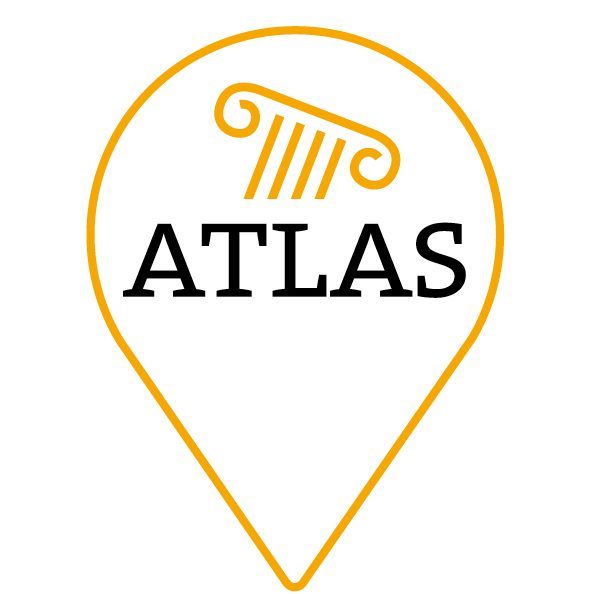For specialists in Late Antiquity such as ourselves to have the opportunity to dedicate a few months to the specific study of Carthage is a marvel. This city offers us innumerable remains of this period and, moreover, with an exceptional monumentality. However, it is equally true that, for the uninitiated, finding one’s way around this immense city and locating the epigraphic and archaeological evidence is not always easy. So when we found out that we were finally going to be able to organise a trip to Tunis to get a better idea of ancient Carthage, we were beside ourselves with excitement! Not only were we going to be able to analyse the city through the literature, but we were actually going to be able to perform a proper autopsy, in situ.
Still, balancing the schedules and flight times of a team spread across Europe is no easy task. Nonetheless, we managed to plan for the week of the 7th of March! Ada and Pieter were the first to arrive in Tunisia on Monday afternoon. Our colleague and ATLAS project member Chokri Touihri was a fantastic host and came to pick us up at the airport. The trip from the airport to our hotel in the centre of Tunis at the Av. Habib Bourguiba was an eyeopener. A three-lane road can easily become five-lane and when you miss your exit you just reverse. The only thing Chokri could say was: “Welcome to Africa!” After the check-in at our hotel Chokri took us to La Goulette to have dinner. The plat du jour was a grilled dorade (from the Gulf of Tunis breaking waves a few metres from the restaurant), accompanied by a brick, a pastry with egg and tuna.
Tuesday, starting to discover Tunis
Tuesday morning Sabine started her journey towards Tunis, whilst Ada and Pieter started discovering the city. On the way to the TGM station, for the tram to Carthage, we were halted by a few Tunesians. They recognised one of us as German (we leave it up to you to decide which one) and started welcoming us and giving tips and advice for our visit! The tram ride was yet another experience we won’t forget soon. It started all easy and with ample space, however, when we got near to Carthage the tram suddenly got so crowded that the doors could not close. Getting out of such an overcrowded carriage did not seem an easy task, but we took advantage of the gap opened by other passengers who were also trying to get out and managed to get off at Dermech station.
We began our visit at the nearby Musée Romain et Paléochrétien, where the basilica known as Basilique Dermech, or Byzantine, or Carthagenna, is located. As we had already discovered, the multiplicity of names for the same site is a common practice in Carthage and although the toponym Dermech is already used elsewhere, it seems that it does not prevent us from using it again… In fact, to our bewilderment, there are several basilicas called Dermech. The Carthagenna, or Byzantine, is one of them and it also has a small museum where some of its most significant pieces are exhibited, as well as others from the nearby Maison des auriges grecs. The basilica is preserved only at the level of the foundation and, at this time of year, it was in full bloom, but it was enough to walk around it to begin to get an idea of the impressive dimensions of the buildings preserved in this city. This is also the case with the basilica of Bir Messaouda, located a few metres from that of Carthagenna, of which only a couple of walls are visible. Even so, the size of the site undoubtedly makes it clear that the dimensions of this basilica were equally large (around 50 m long!).

From here we continue our route to the archaeological area of the Baths of Antoninus. In this area there are several remains of interest for our project, such as the Basilique Dermech I (yes, this place name again), also known as the Basilica of Douïmes. In addition, we also visited the so-called Chapel d’Asterius and, to someone’s delight, the late-antique dwelling known as Maison du Triconque. It was impossible to keep up with Ada as she managed to record all finds, including a portable scale in all pictures.
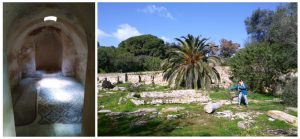
Of course, we did not fail to visit the imposing Thermes d’Antonin either, even though they are far from our period of study. The truth is that the immensity of this building and its magnificent state of conservation left us speechless. So, after a coffee while contemplating this monumental landscape overlooking the sea, we walked around the corners of these thermal baths, admiring their architecture but also the fantastic preserved epigraphy. Here Pieter got really delighted as the epigraphy was to be found everywhere. His delight of seeing the letter shape of the K in the monumental inscription (AE 1949, 27 and 28) and realising it was not only to Marcus Aurelius and Lucius Verus, but also had a second inscription to Theodosius and Arcadius!
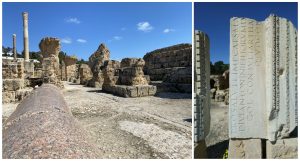
The archaeological site of the Villes romaines was the last visit of the morning, where we encountered several well-preserved aristocratic houses with a late antique chronology: the Maison du Cryptoportique, the Maison de la Rotonde, the Maison de la Volière, or the Maison de Bassilica, among others. It is here that we find the Mosaïque des cheveaux that we described in a tweet. Passing through the fantastic peristyle gardens and luxurious representation rooms we got an idea of what a privilege it must have been living in places like these. Far from the bustle of the forum and the commercial and port areas, but still with excellent views of the sea and the Gulf of Tunis.

After this visit, Pieter and Ada headed for the Musée de Carthage (not without a detour), as we had a meeting scheduled with the illustrious researcher Lilian Ennabli and Sihem Aloui. Mrs Ennabli is the person you need to know when studying Christian Carthage. She has written several books on this subject, but also the main epigraphic corpora on Christian epigraphy. But, before the meeting, Pieter and Ada wanted to go into the museum to get something to eat, so at the ticket office they made sure that they could get back in with the same ticket, in case they had to go out to look for Mrs Ennabli. The man at the ticket office made them confirm at least twice that they really did have a meeting with Mrs Ennabli, looking at them as if they were crazy, and even called his colleague to comment on the strange circumstance of apparently two “tourists” having a meeting with Mrs Ennabli. In the end, after the small fuzz, there was no problem and Pieter and Ada were having lunch in the museum gardens with Sabine and Chokri, who arrived shortly afterwards.
The meeting itself was very helpful. Lilian Ennabli was very kind and pointed out some of the most relevant aspects of what she calls Christian Carthage. In addition, we met Sahim Aloui, a researcher who is currently working on the Damous-el-Karita inscriptions, and Moz Achour, curator of the museum. With these specialists on late antique Carthage we discussed the possibilities for the 3D reconstruction of the basilicae and where to find the necessary bibliography. In addition, we were able to show them our WebGIS and the work done so far, which was very well received and generated a great deal of interest.
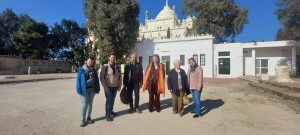
At the end of the meeting, our host Chokri took us to see other, even more impressive, archaeological sites. We visited the amphitheatre, where Perpetua and Felicitas, the first documented Christian martyrs of Roman Africa, were executed. From here we went to the cisterns of La Malga, an immense set of huge cisterns, designed to collect water from the aqueducts to supply the city. Finally, we enjoyed a leisurely stroll through the beautiful streets of Sidi-Bou-Saïd and a cup of mint tea with almonds, with a wonderful view of the Gulf of Tunis.
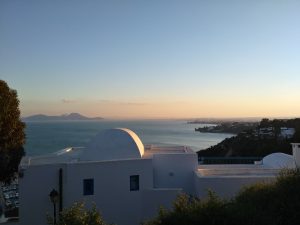
Wednesday, visit to the INP and the Medina
The next day the ATLAS core team was completed, as Laurent arrived on Tuesday evening. We started the day with a morning visit to the Medina of Tunis, walking through several of its winding streets and visiting some of its marvellous corners. One of them was, to our surprise, Chokri’s own office in a beautiful historic building with a magnificent decoration of decorated stucco and tiles. Can you imagine working in such a place? Some of us would certainly love it…
From there we headed to the headquarters of the Tunisian Institut National du Patrimoine (INP), whose building is equally fantastic. Here we were welcomed by Mohedinne Chaouali, also a member of our project, who was waiting for us for a meeting with the directeur général of the INP. Sabine and Laurent presented the project and explained what we planned to do in the next two years. The meeting was a success as we can count on the co-operation of the INP in our future ventures.

After the meeting we went to a conference room because, as we announced on our Facebook page and on Twitter, the directors were invited to give a lecture about the project. However, setting up and connecting the computer and projector in this room was not an easy task. Working in historic buildings has an undeniable charm, but sometimes it can be difficult to solve technical issues. But thanks to the attentiveness of our guests, we finally managed to get everything working and Sabine and Laurent were able to present the ATLAS project to a really interested audience, which led to a lively discussion after the talk.
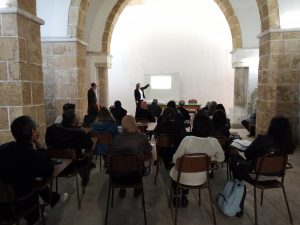
After the discussions, which continued for quite a while in the square in front of the INP, we headed with our INP hosts to the Medina for lunch. Wandering through the narrow streets and still talking about ATLAS, one of our Tunesian colleagues greeted another INP member heading towards us. It was only when we paid attention to the group that we noticed that Antonia Bosanquet from the RomanIslam Center and our own ATLAS member Anne Leone were heading towards us. What are the odds of such an encounter in the winding streets of Tunis? After a short chat we decided that we’d meet again later that day for dinner. Because we needed to go on as we had to be on time for, well… lunch.
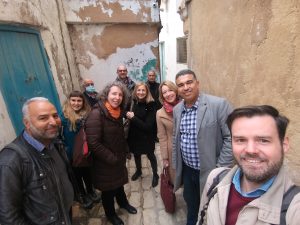
The restaurant we had lunch at a former funduq, or inn, splendidly preserved and refurbished. It is interesting to see how the narrow streets of the Medina hide such spacious courtyards with such green patios. Our table had sol y sombra, which was easily solved by straw hats. We thought it looked a bit silly and admittedly the Hamburgians were quite happy with some sun. The food at the place was great and we thank the INP for taking us!
After the lovely lunch it was time to go back to work. The INP was so kind to provide us with two cars and drivers to facilitate visiting different parts of the city. In addition, we were accompanied with a guide to show us the sites at Carthage. We started at the Basilica dite sainte Monique, or basilica Saint Cyprian. Not much remains of this basilica, so having a guide explaining where to look to get an idea of the dimensions was much needed. Thereafter we visited the Villas romaines, which Ada and Pieter had already visited. However, we could clarify some questions we had. The piscina in one of the villas, we wondered why it was in a villa, appeared to be a late 20th century “reconstruction”… Next up was the Damous-el-Karita, this basilica is even more impressive than the basilicas we visited on Tuesday! Already from the main road you can appreciate the immense size of the basilica, which measures up to 1,5 ha. The reconstructed rows of columns give you a good indication of the size of the nave and aisles of the main building. The massive basilica is part of an incredibly large ecclesiastical complex, including a baptistere, an assembly hall and a big circular subterranean martyrium.

Thursday, a tour to the inland sites of Tunisia
We had a really early start on this day. We had breakfast at an unholy hour, 6 o’clock in the morning. Even the baker was asleep as bread was only delivered at 6h45. Luckily the Carlton provides ample choice beyond your pain et croissant and we could eat before the fresh bread arrived. At seven sharp the two cars with drivers, so kindly provided by the INP, were ready to take us to Makthar and Zama Regia. We took off in different directions: Chokri, Sabine and Ada directly towards Makthar, whereas Laurent and Pieter took a detour via Bou Salem to pick up Moheddine. In the late morning, we arrived at Makthar for a guided tour by Moheddine. The site is very impressive, so much archaeology and epigraphy is to be seen and researched. Moheddine brought us along all Late Antique remains to present us with all Makthar has to offer. The site is indeed very interesting and we are looking into the possibilities to add Makthar. Maybe you’ll read more about it in our future blogs. Halfway our visit Moheddine had a small surprise for us: we were offered a second breakfast with pizza. After this Hobbit-like breakfast and visiting the rest of the site it was time for our next destination.
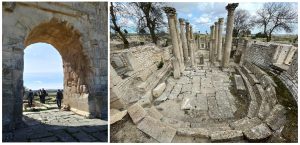
After a little less than an hour’s drive we arrived at Zama Regia, where they offered us a whole feast to eat, including homemade couscous! Here we met the archaeologists and students who make up the team that works at this site, where they also have facilities to stay and carry out the necessary research tasks after the excavation itself. They were our guides in the visit to the extensive site, whose long occupation and deep stratigraphy left us speechless. But also the landscape of the area, with vast plateaus, so different from the coastal landscape, was fascinating to us. After 20 years of excavations, they have been able to bring to light part of the monumental area of the Roman city, including a huge temple with complex architecture; the perimeter of the wide Byzantine fortress; and a sector of the early mediaeval settlement. But, without a doubt, the site has much more to offer. We will be attentive to future discoveries!

Returning to Tunis, we relied again on our two drivers from the INP who so kindly had been driving us around since Wednesday afternoon and the whole Thursday. We observed them with awe and a touch of fear as they navigated through the busy streets of Tunis and the local roads between Mactar and Zama. As we had two cars we always had to go on separate ways: Chokri, Sabine and Ada took the direct route to Tunis, while Moheddine, Laurent and Pieter went through Bou Salem to drop off Moheddine. As the trip via Bou Salem was with a slight detour we noticed that Sabine and Ada were quite content going the direct route and avoiding more travel. Laurent and Pieter went on their way to Bou Salem, admittedly with a bit of jealousy towards the direct route, but they made good use of the time discussing many things during the ride, amongst which the differences between academia in Tunisia, France, Germany and the Netherlands.
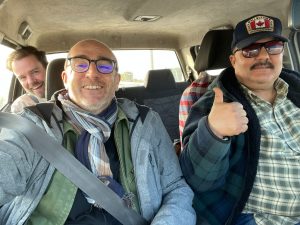
Friday, the day of return
The day before we said goodbye to our Tunisian colleagues as we had to catch our flights back at different times in the morning on Friday. The truth is that we had mixed feelings, some of us would have stayed another week… Tunisia has fascinated us, especially those of us who did not know it, and we are looking forward to returning. That morning, Sabine, Laurent, Pieter and Ada had their last breakfast at the Carlton, commenting on the great opportunity that it has been to be able to organise this trip and get to know all these late antique sites and remains at the hands of the true specialists who, so kindly, have accompanied on our visit. We have returned to our respective offices with something from Fernweh, but with renewed energy and, without a doubt, greater knowledge to continue our research on late ancient Carthage.
